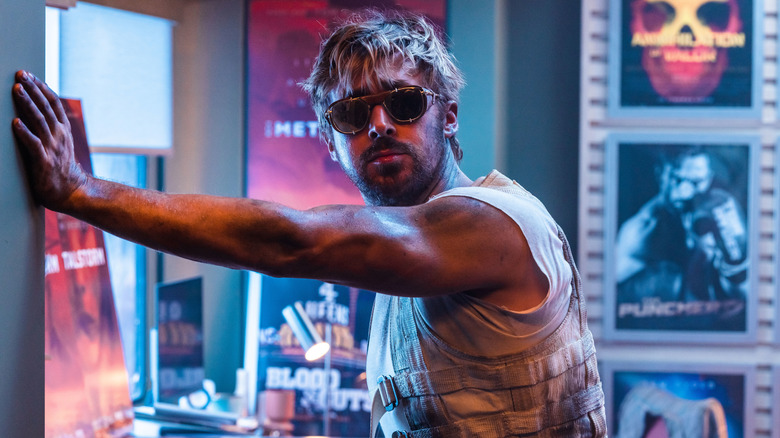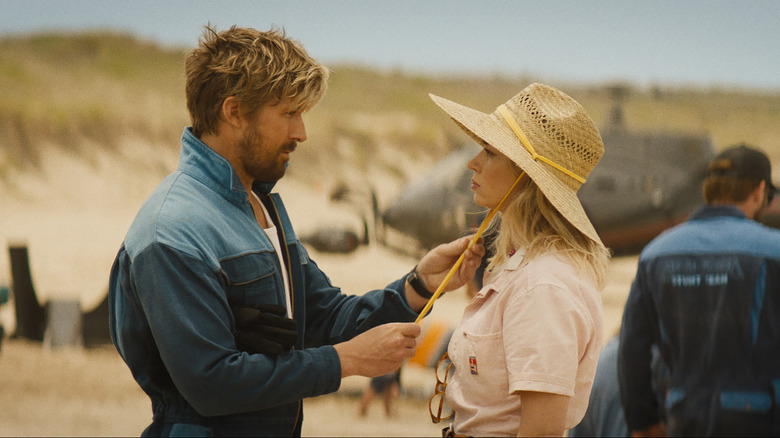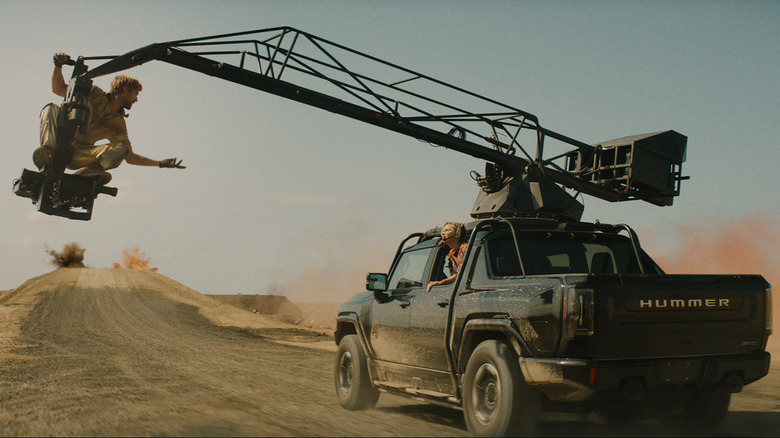The Fall Guy Review: A Crowd-Pleasing Love Letter To Stuntmen
- Ryan Gosling has never been more charming
- The action set pieces are exemplary
- Often a little too meta for its own good
- Hampered by a bloated and busy plot
There is no category at the Academy Awards for stunt work. This is both a travesty and something "The Fall Guy" repeatedly reminds you throughout the course of its 126 minutes. Even through the film's credits, interspersed with footage behind the scenes of the stunning action set pieces the viewer has just experienced, there is an ever-present sense that a case is being pleaded. That a great injustice is in the process of being rectified.
But director David Leitch, a former stuntman himself, couches these serious labor concerns about the lack of recognition for some of Hollywood's hardest-working creatives in one of the most buoyant, crowd-pleasing popcorn flicks in recent memory. Even though the film is essentially a sonnet with car crashes dedicated to the men and women behind the movie stars, much of the film's majesty comes directly from the charisma of its leading man.
No other film has so successfully utilized every ounce of Ryan Gosling's unique screen presence. Gosling has played a stunt performer previously in "Drive" and "The Place Beyond The Pines," so perhaps that is why he's such a perfect fit here. Much the way he used his Ken in "Barbie" as a postmodern stand-in for the plight of disaffected young men, his performance here makes him a surprisingly effective advocate for the movie industry's unseen laborers who literally set themselves on fire for our entertainment.
Is this a romantic comedy or an action thriller?
In the '80s television series of the same name, Lee Majors plays Colt Seavers, a Hollywood stuntman who moonlights as a bounty hunter, creating an excuse for him to have episodic adventures every week using his skills from the set in action. But Ryan Gosling's Seavers holds no such side gig, so the film takes a drastic approach to getting similar results absent the efficacy of such a simple premise. "The Fall Guy" is first and foremost a love story, that then must do somersaults to necessitate the requisite amount of action and thrills.
Seavers, a professional stunt double, and his frequent co-worker, a camera operator named Jody Moreno (Emily Blunt), fall for one another on set, sneaking into trailers for discreet smooches between takes. But he suffers a serious injury doing a difficult stunt and shuts her out of his life during his recovery. When he's asked to return from his self-imposed retirement because Jody wants his help on her first outing as a director, a sci-fi western called "Metalstorm," he sees this as the perfect opportunity to win her back. But when he arrives on set in Australia, he discovers he was lied to by the film's producer Gail (Hannah Waddingham), and that Jody had no idea he was coming — nor does she want him there. Gail has brought Seavers in to use his stuntman mojo to find the film's missing star Tom Ryder (Aaron Taylor-Johnson), a man he has doubled for countless times and knows intimately. But, predictably, all is not as it seems, and this film takes a more literal interpretation of the show's original title to get through its many twists and turns.
Initially, this is a problem. David Leitch and screenwriter Drew Pearce have a story that is needlessly convoluted and denser than a film this airy ought to be. "The Fall Guy" aims to be several different films at once; Pearce is clearly channeling his "Iron Man 3" collaborator Shane Black in penning a cheeky and edgy send-up of action movie tropes and the movie business itself. But he's also writing a touching — albeit if criminally self-aware — romantic comedy between two stars with remarkable chemistry. Within that, Leitch is also trying to stage a rollicking action picture with well-orchestrated set pieces that each need their own room to breathe for effective setup and execution.
The plot that stitches it all together has more than its fair share of issues. Jokes don't always land as well as the punches in the fight scenes; the lazy references to other movies often feel like placeholders someone forgot to take out later; and the metacommentary works best as a soupçon and not a buffet. Having characters on screen talk about how contrived something is doesn't make it any less contrived.
But there is a point where, against all odds, these disparate elements coalesce enough for the greater whole to shine, regardless of its many weak points. It comes when the love story depicted on-screen dovetails with the love story happening off-screen, the one between all the stunt people making this film and all the ones whose shoulders they're currently standing on.
It's both! It's paradoxical — and yet it works
Without spoiling too much, there is a beautiful speedboat chase at the heart of the film where the whole vision comes together.
Throughout this twisty-turny tale, we watch Ryan Gosling's Seavers take hit after hit, both on the set of "Metalstorm" and in the battles he experiences trying to find Ryder — but it's the emotional lumps he takes for abandoning Emily Blunt's Jody that hurt the most. In a good romantic comedy, the story must find things to keep the two lovers apart until the climax. In 'The Fall Guy,' everything prominently featured in the advertisements — the B plot about Ryder's disappearance, the punching and kicking, the car flipping, and the explosions — serves as a physical manifestation of Seavers' inability to communicate his fears and vulnerabilities. It is ultimately easier for him to be dropped from high heights and be set on fire than it is to face the thought of losing Jody forever.
These two performers absolutely kill it, making their connection to one another feel believable in the middle of all the film's spectacle and bombast. Blunt, in particular, is a pleasant surprise, taking a role that could easily have been a flat love interest and making her just as layered and lovable as Gosling's leading man. Rather than making her the damsel in distress, Blunt gets to kick the same kind of ass she got so ripped for in "Edge of Tomorrow." But in the same way romcoms need palpable chemistry to fan the flames of love, a good action picture needs action that moves the story forward and doesn't feel superfluous or just for show.
By binding every well-composed and sharply staged action scenes to the omnipresent awareness of what it took for the performers to perform these stunts, the film is able to take what would usually be seen as action just for action's sake as being part and parcel of the film's magic. Jody speaks of "Metalstorm" as her trying to find a way to communicate love through action on camera, and David Leitch does exactly that — but it's a love for his collaborators, on this film and every other one he's ever worked on. In pulling back the curtain, the audience can see how many special effects are achieved without CGI but rather with the blood, sweat, and tears of living, breathing humans.
Since they parted ways, his former co-collaborator Chad Stahelski has gotten more critical acclaim for iterating and evolving in the "John Wick" world while Leitch has developed a more eclectic but ultimately uneven filmography. Regardless of their commercial success, there is no real throughline of quality between mixed bags like "Deadpool 2," "Hobbs and Shaw," and "Bullet Train." Here, however, he beats the Marty Janetty allegations, proving he's not the lesser of the two former tag team partners. In "The Fall Guy," he has produced his best work to date.
"The Fall Guy" arrives in theaters on May 3.


